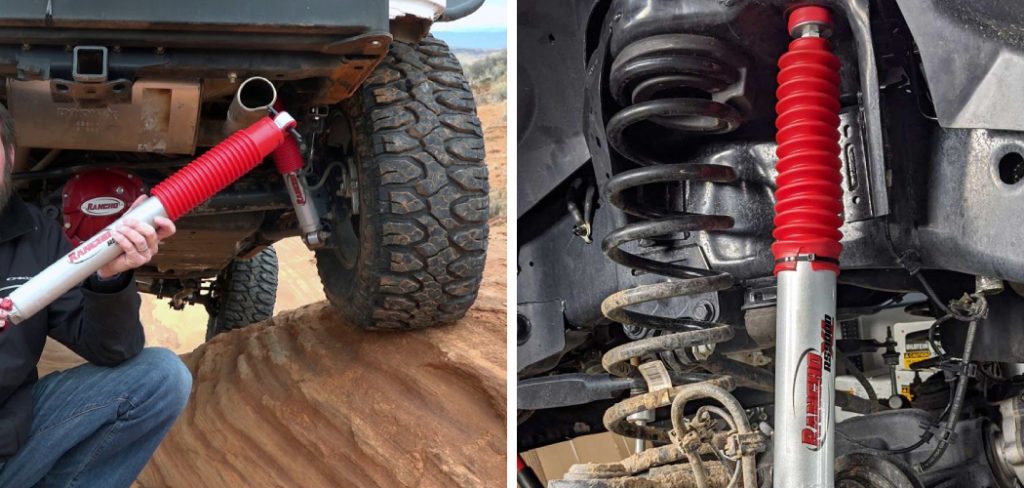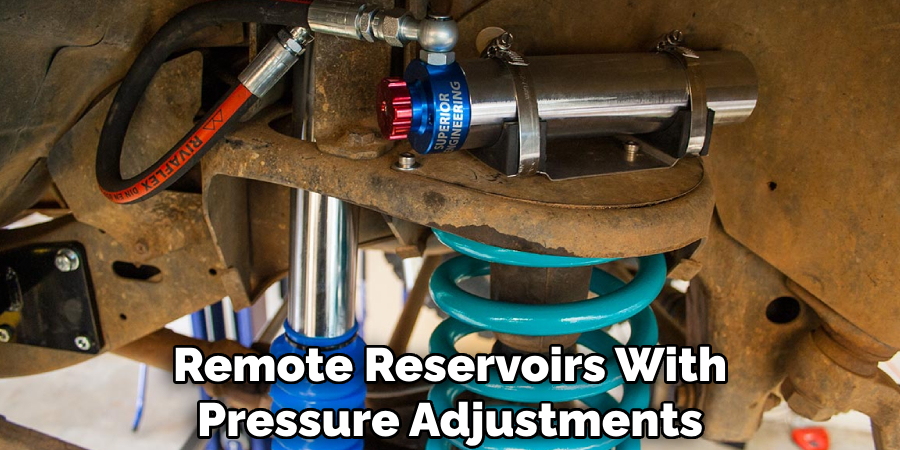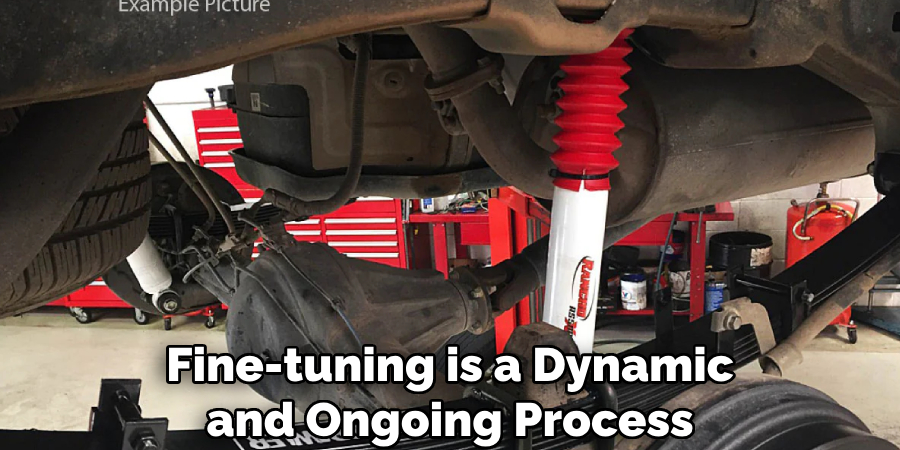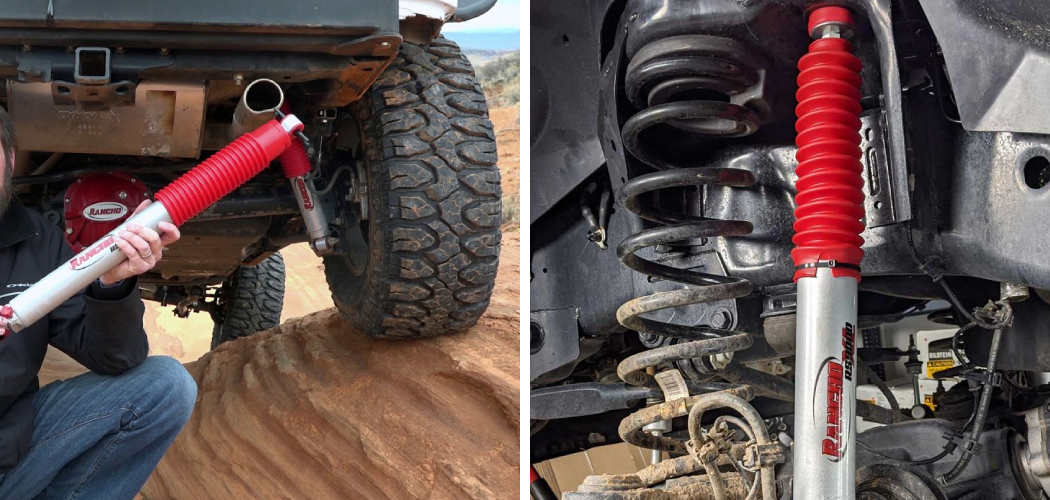Rancho shocks are renowned for their robust construction and adjustable design, offering unparalleled control over your vehicle’s suspension performance. Learning how to adjust Rancho shocks enhances riding comfort and improves overall handling, especially when traversing unpredictable terrains. The brand’s lineup includes various models, such as the RS9000XL and quick lift, each featuring distinct adjustability options from precision-tuned knobs to advanced damping mechanisms, enabling drivers to tailor their ride according to individual needs and preferences.

Understanding Shock Absorbers and Adjustment
Shock absorbers are a critical component of a vehicle’s suspension system, designed to absorb and dampen road impact and vibrations. When your car encounters uneven surfaces, the shock absorbers control the motion of the wheels to maintain road contact, thereby ensuring a smoother ride. Without effective shocks, vehicles would bounce uncontrollably, resulting in discomfort for passengers and increased wear on other suspension components.
There are primarily three types of shock absorbers: monotube, twin-tube, and adjustable.
Monotube Shocks:
Monotube shocks consist of a single tube filled with gas and oil, separated by a floating piston. This simple design allows for consistent damping and is less prone to aeration because the oil doesn’t mix with the gas.
Twin-Tube Shocks:
Twin-tube shocks, on the other hand, have two inner and outer tubes, allowing for more fluid to move through and offering a more comfortable ride quality.
Adjustable Shocks:
Lastly, adjustable shocks, such as those offered by Rancho, allow you to customize the ride by changing the stiffness or damping levels.

Understanding the key terms related to shock adjustment is essential to ensure your vehicle handles as expected. Damping is the process of controlling motion through the shocks, affecting how quickly the vehicle responds to changes in the road surface. Rebound refers to how the shock absorber returns to its original position after being compressed, whereas compression is the process of the shock absorbing the impact from the road. Stiffness, often controlled by these adjustments, dictates how firmly the vehicle responds to the road or load changes.
Adjusting your shocks can directly influence your ride quality, handling, and performance. Increasing stiffness through adjustments can lead to a firmer ride, more suited for heavy loads or aggressive driving, such as off-roading, where precision control is paramount. Conversely, softening the adjustment will generally yield a smoother ride, ideal for everyday commuting. Therefore, understanding how to adjust Rancho shocks is not just a matter of personal preference but also a crucial aspect of vehicle safety and performance optimization.
Identifying Your Rancho Shocks
Identifying your vehicle’s specific Rancho shock model is the first crucial step toward proper adjustment and maintenance. Each model comes with its unique set of features and adjustment mechanisms, making it essential to know which one you’re working on to achieve optimal performance. To identify your Rancho shock model, look for the model number typically found on a label or stamped directly onto the shock body. This number is the key to unlocking detailed product information.
Once you have the model number, you can utilize several online resources to further understand your shocks. Rancho’s official website offers comprehensive product details, including the type of adjustment mechanisms your model utilizes—whether it’s knob-adjustable, dial-adjustable, or another type. Additionally, the site can guide you through proper adjustment procedures for your specific model. Equipped with the model number, you can also refer to vehicle forums, where fellow enthusiasts and experts can offer advice and insights based on their direct experience with Rancho shocks.

Some Rancho models might feature a simple knob adjustment, such as the RS9000XL, which allows for quick alterations to the damping level, while other models may have a more intricate dial-adjustment system or a combination of both. Furthermore, certain models might be vehicle-specific or designed for particular driving conditions. Regardless of the type, understanding your Rancho shocks’ adjustment mechanisms is crucial for tailor-fitting their performance to your driving style and ensuring longevity and safety. Familiarizing yourself with the specifics of your Rancho shocks lays the foundation for a more stable and responsive ride, translating to a safer and more enjoyable driving experience.
Understanding Your Driving Needs and Terrain
Before adjusting your Rancho shocks, you must ponder your driving habits and the terrains you typically encounter. Different driving styles and terrains demand specific shock settings to balance comfort, control, and vehicle performance.
Driving Styles Defined:
- Daily Commuting: This style involves routine trips, often on paved roads, focusing on comfort and fuel efficiency. The required shock setting usually favors softer damping to absorb road imperfections for a plush ride.
- Off-Road Adventure: Off-road driving demands a shock that can withstand and adapt to rough, uneven terrain. Enhanced control and stiffer damping are crucial to stabilize the vehicle and absorb large bumps or obstacles.
- Towing and Hauling: If you regularly tow trailers or carry heavy loads, your shocks should be adjusted for firmer resistance to prevent excessive sagging and maintain vehicle control during load transfer.
- Performance Driving: Enthusiasts looking for an agile response from their vehicle during spirited drives may prefer a tighter suspension with less body roll, afforded by stiffer damping settings.

Common Terrains:
- On-Road Terrain: Standard highways and city streets with minor imperfections. Comfort is typically preferred; therefore, a medium to soft shock setting is ideal.
- Light Off-Road Terrain: Dirt roads and gravel paths with occasional obstacles. A medium to stiff shock setting offers a balance between comfort and adaptability.
- Heavy Off-Road Terrain: Challenging trails with rocks, mud, and ruts demand a stiff setting for better vehicle control and to safeguard the undercarriage from severe impacts.
Adjusting to Your Needs:
Every driver and trail presents unique requirements. For daily commuting, a softer setting may be the best fit to ensure comfort over long distances. Meanwhile, off-road drivers might prioritize a firmer setup to tactically navigate over rocks and ruts while sustaining proper traction. For those who tow or haul frequently, an increase in the shock’s firmness is essential to combat the additional weight and maintain proper ride height, which is critical for safety and ease of handling. If your activities lie in the realm of performance driving, stiff settings will give you the responsiveness and tight handling to corner with confidence.
Your optimal shock setting is a harmony between the firmness required by your load and terrain and the control needed to safely manage your vehicle’s reactions. Adjusting the settings on your Rancho shocks to reflect your driving style and terrain not only preserves the integrity of your suspension system but also enhances your driving experience, ensuring you are prepared for the demands of any journey.

Safety Precautions and Tools
When adjusting your Rancho shocks, it is critical to prioritize safety to prevent accidents and avoid harming your vehicle. Working on a vehicle’s suspension system requires attentiveness and adherence to proper safety protocols.
Essential Safety Precautions:
- Secure Your Vehicle: Always park on a level, stable surface with the parking brake engaged. This prevents the vehicle from rolling or shifting while you’re working.
- Use Jack Stands: After lifting the vehicle with a jack, place the jack stands beneath the vehicle frame for secure support. Never rely on Jack alone.
- Wear Protective Gear: Don safety glasses and gloves. Small particles and debris can cause injury when loosening or adjusting components.
- Stay Organized: Keep your tools and parts organized to avoid tripping hazards and to easily locate necessary items.
- Work in a Well-Lit Area: Adequate lighting is essential to see what you’re doing and avoid mistakes.
- Avoid Hot Components: Allow your vehicle to cool down before starting any work to prevent burns from hot parts.
Basic Tools Required:
To adjust your Rancho shocks, you will need a few essential tools. This includes:
- Wrenches: Standard and adjustable wrenches to turn bolts and nuts.
- Screwdrivers: For prying or adjusting components that may require it.
- Adjustment Tool: Some shock models come with a specific adjustment tool.
- Torque Wrench: To ensure that all fittings are tightened to the manufacturer’s specifications, which is crucial for safety and performance.

Adhering to these safety measures and having the correct tools on hand will help ensure that your maintenance or adjustment task is completed safely and effectively. Remember, taking shortcuts can compromise your safety and your vehicle’s reliability.
How to Adjust Rancho Shocks: Specific Adjustment Instructions
Understanding the unique adjustment mechanisms of Rancho shocks is essential for fine-tuning your vehicle’s performance. From knob to dial adjustments, each system offers a range of customization to enhance your driving experience. Following the manufacturer’s guidelines and learning your shock absorbers’ intricate details will improve vehicle handling and comfort.
1. Knob-Adjustable Shocks (RS9000XL):
The RS9000XL series comes with a user-friendly numbered knob that allows drivers to select from several predefined settings. Each setting adjusts the shock’s damping force – the lower the number, the softer the ride; conversely, the higher the number, the firmer the suspension.
Recommended Settings Chart:
| No. on Knob | Daily Commuting | Light Off-Road | Heavy Off-Road | Towing/Hauling | Performance Driving |
|————-|—————–|—————-|—————-|—————-|———————|
|1 – 3 | Comfort | – | – | – | – |
|4 – 6 | – | Comfort | – | Light Loads | – |
|7 – 9 | – | – | Utility | Heavy Loads | Agility |
Tips for Fine-Tuning:
- Start with the recommended settings and adjust incrementally for personal preference.
- Note changes in ride quality and handling with each adjustment to understand the impact.
- Use a notepad to record settings for specific conditions for future reference.
2. Dial-Adjustable Shocks:
Dial-adjustable shocks feature a dial mechanism that offers precise control over the damping force. Turning the dial changes the flow of hydraulic fluid within the shock, thus altering the resistance and ride stiffness. The dial typically features a range of settings, labeled numerically or with symbols, which adjust the shock from soft to firm.
Dial Settings Recommendations:
| Dial Setting | Daily Commuting | Light Off-Road | Heavy Off-Road | Towing/Hauling | Performance Driving |
|————–|—————–|—————-|—————-|—————-|———————|
|Low | Comfort | – | – | – | – |
|Medium | – | Balance | – | Moderate Loads | – |
|High | – | – | Control | Heavy Loads | Precision |
Adjustment Tips:
- Begin with moderate settings before moving towards the extremes to understand the influence on your vehicle.
- Always return to the manufacturer’s default setting before adjusting for a baseline comparison.
- For consistent road conditions, find your optimal setting and keep a record for ease of future adjustments.
3. Other Adjustment Mechanisms:
Some Rancho shock models may employ unique mechanisms, such as remote reservoirs with pressure adjustments or compression and rebound tuning features. For these, the adjustment process can vary greatly, and it is imperative to consult the specific model’s user manual.

Important Considerations:
- Always consult your user manual for detailed instructions relating to your specific shock model.
- Recognize that each vehicle and driver will have a unique optimal setting; personal testing and gradual adjustment are key.
- Remember that too firm a setting can lead to a jarring ride and potential vehicle damage, whereas too soft may result in loss of control.
4. Emphasizing Safety:
When adjusting your Rancho shocks, always prioritize safety. Consult the vehicle’s service manual, use proper tools, and follow all recommended safety procedures. Accurate adjustments contribute to the longevity of your shocks and ensure that your driving experience is safe and enjoyable.
Testing and Fine-Tuning
After adjusting your Rancho shocks, it’s crucial to test your vehicle under various driving conditions to evaluate the effectiveness of your tuning. This process allows you to ensure your adjustments correlate with the desired handling characteristics and comfort level.
Importance of Testing Adjustments:
Testing is integral as it confirms whether the alterations have improved the ride quality without compromising safety. On-the-road testing helps you identify the immediate impact of your changes and offers practical insight into whether further tweaks are needed.
Safe Testing Practices:
- Start by testing in a controlled environment, such as an empty parking lot, to feel the initial effects.
- Gradually move on to familiar roads with varying surfaces to understand how the changes affect comfort and control.
- Proceed to more challenging terrains or heavy-load driving, if applicable, to evaluate performance under specific conditions.
- Always adhere to traffic laws and never test in conditions you’re not experienced with.
- If possible, have a co-driver who can record observations and provide feedback on vehicle behavior.
Encouraging Fine-Tuning:
As each driver’s preference and vehicle load-out is unique, fine-tuning the settings based on your experiences is vital. Use your testing sessions to adjust the settings incrementally.
- Keep detailed notes on your settings for each test run and how the vehicle responded.
- Pay attention to how the ride feels—whether it’s too stiff, too soft, or if there are vibrations or noises.
- Take into account the feedback from any passengers or observers.
- Remember, what works on a smooth highway may not suit a rugged trail—adjust accordingly.
By understanding that fine-tuning is a dynamic and ongoing process, you can continually refine your vehicle’s performance to match your driving preferences and the demands of various terrains. This personalized approach ensures maximum comfort, safety, and vehicle efficiency.

Maintenance and Troubleshooting
Maintaining your Rancho shocks ensures they perform optimally throughout their service life. Basic maintenance should include periodic checks and cleaning. Rotate the adjustment knobs to their softest setting and back to your preferred setting to ensure they remain free of dirt and debris, which can affect performance. Wipe down the shock bodies with a clean, dry cloth, and inspect for any signs of wear or damage, such as oil leaks or corrosion.
Basic Maintenance Tips:
- Regularly inspect shocks for signs of oil leakage or damage.
- Clean shocks with a damp cloth to remove dirt and grime.
- Lubricate adjustment knobs, if applicable, with silicone-based lubricant.
- Check that mounting bolts and other hardware are tight and in good condition.
Common troubleshooting issues may include an uneven ride, an imbalance in shock settings, or potential mechanical problems. Excessive noise, such as knocking or squeaking, could indicate loose components or the need for lubrication. If any issues persist or if you’re unsure of any symptoms, consult a professional mechanic. Specialized tools and expertise may be required for diagnosing and rectifying complex problems.
Troubleshooting Tips:
- If experiencing an uneven ride, check that all shocks are adjusted to the same setting and inspect for mechanical issues.
- For unusual noises, verify that all mounting hardware is secure and lubricate joints if necessary.
- When faced with persistent problems, seek professional assistance immediately.
Regular maintenance and prompt attention to any issues will keep your Rancho shocks in top condition. However, understanding when to call in a professional is just as essential for preserving your safety and the integrity of your vehicle’s suspension system.
Conclusion
In conclusion, understanding how to adjust Rancho shocks is pivotal to achieving the ideal balance between a smooth, comfortable ride and a resilient, controlled driving experience. Part 2 of our guide emphasized the critical nature of tailoring shock settings to individual preferences and diverse driving conditions. It underscored the significance of consulting your model’s user manual for precise guidance and the importance of deliberate, gradual adjustments to ascertain the optimal configuration.
Adjusted correctly, Rancho shocks will not only enhance the comfort of your ride but also ensure safety and vehicle integrity across varied terrains. We highlighted the need for regular maintenance and the importance of being attentive to potential troubleshooting signs to maintain shock performance and longevity.
We encourage all vehicle owners to appreciate the benefits of finely tuned Rancho shocks and recognize the continuous nature of this tuning process. The Rancho website offers extensive resources for additional support, and our customer service team is available to assist with any inquiries. Always remember to revisit the basics of adjusting Rancho shocks to preserve the quality and safety of your driving experience.

